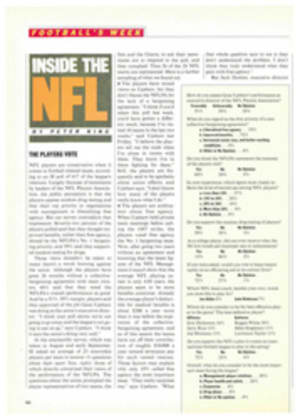
Letters
BIG-TIME SOLUTIONS
Many thanks to Rick Telander for his no-holds-barred dissection of major-college football (Something Must Be Done, Oct. 2). It's time everyone acknowledged the hypocritical facade we've built for this multimillion-dollar industry. How much lower can we permit standards to fall? How many more corrupt athletic programs will we tolerate before we inaugurate Telander's AGPFL (Age-Group Professional Football League)?
JOHN A. RAUSCH III
Arlington Heights, Ill.
Rick Telander for commissioner of the AGPFL, and the sooner the better.
KENNETH E. MILLER
Rochester, Minn.
I particularly like the recommendation that AGPFL athletes who qualify be given academic scholarships that they can use at their discretion. Nothing, especially not NCAA Propositions 42 or 48, will enhance the academic performance of athletes as much as giving them the opportunity to pursue their education at a time when they decide that education is their primary concern.
STEVE HEBOLD
Athletic Director
East Lansing (Mich.) High
As an associate professor of economics at Canisius College (Division I in basketball, Division III in football), I applaud Telander's proposed solutions to the ills of Division I-A football. I suggest, however, that under-the-table payments by boosters to AGPFL players would continue if the players were restricted to a "reasonable pay scale." Why not pay what the market dictates?
F. SCOTT WILSON, PH.D.
Snyder, N.Y.
There is no question that Telander has identified many of the ills that beset college football. To think, however, that his proposed AGPFL would do anything to correct the problem is at best naive. Such a move would merely introduce a stratum of professional sports to which even a high school player could aspire. The ills of college athletes who receive little or no education would merely be transferred to the high school system. We would then have a new group of young people with the same woes but with even less maturity and experience to call on to confront them.
A far better solution is to address the faults in our educational process. Something is fundamentally wrong with any system that allows a student—athlete or otherwise—to leave high school as a functional illiterate.
TONY COLLINS
Yonkers, N.Y.
I am afraid that Telander doesn't see the big picture. Here is a man who makes his living aggrandizing kids' games, who works for a magazine that makes household names of 18-year-old freshmen. When we get a glossy high-circulation national magazine called Scholars Illustrated, we'll know that Americans truly care about education.
PAT CRANDALL
Bowie, Md.
Rick Telander reasons that reporters on the school paper get paid, so why shouldn't football players. I doubt if many reporters enjoy full scholarships, free room and board, or perks like a reporters' dorm.
DONNA MILLS
Middletown, Ohio
Telander misses the mark when he states, "Vince Lombardi did more to corrupt the profession of football coaching than any man before or since." I submit that the press's perception of Lombardi did the corrupting. The vast majority of his former players have achieved notable success in the real world. This is well documented and stands as a direct refutation of the claim that coaches educate their athletes in a "dysfunctional manner."
JEFF DECOLA
Key Largo, Fla.
Although Telander can't remember learning anything from his Northwestern coach, Alex Agase—who, by the way, is one of the finest gentlemen ever to enter the coaching profession—he should have taken Agase's advice and gotten a haircut. He still needs one.
CHUCK HOWLAND
Wilmette, Ill.
Why is Telander so angry? It's homecoming on a crisp fall Saturday. The school band blares the alma mater, and 50,000 fans rise in unison as the home team takes the field. Alumni have come from far and wide to savor this autumn ritual and to renew old friendships at class tents and tailgate parties. Faculty and their families relish the chance to share this common enthusiasm. In their reserved section at midfield, the gaily plaided women's field hockey squad—one of 17 other teams that depend on football revenues—has just arrived from its own homecoming game. Fresh-faced cheerleaders elicit the loudest applause from the undergraduate block, where more than half the student body—at little or sometimes no charge—enjoys a respite from studies. Confetti, camaraderie and conviviality fill the air, and for a few hours, at least, all's well with the world.
A bit idealized? Perhaps, but my scenario is more representative of college football than Telander's tiresome polemic. Come on, Rick, lighten up. Or go rain on someone else's parade.
STEPHEN R. FAHEY, M.D.
Sports Medicine Division
University of Maryland Health Center
UBIQUITOUS WALL
Hats off to Peter Alson for his interesting SIDELINE (Sept. 25) on playing Wiffle Ball in the shadow of a backyard reproduction of Fenway's Green Monster. As students at Georgetown, we lack the outdoor space for such a project, but we share an unbounded love for the Wall. Within hours of arriving on campus this fall, we began to transform our dorm room into Little Fenway. The scoreboard of our Wall, which even includes Tom and Jean Yawkey's initials in Morse code, was designed to depict the moment preceding Carlton Fisk's historic home run in Game 6 of the 1975 World Series.
MARK A. CORCORAN
PETER G. MARTIN
DAVID M. WULF
Washington, D.C.
PHOTO
PETER G. MARTIN
Letters to SPORTS ILLUSTRATED should include the name, address and home telephone number of the writer and should be addressed to The Editor, SPORTS ILLUSTRATED, Time & Life Building, Rockefeller Center, New York, N.Y. 10020-1393.

